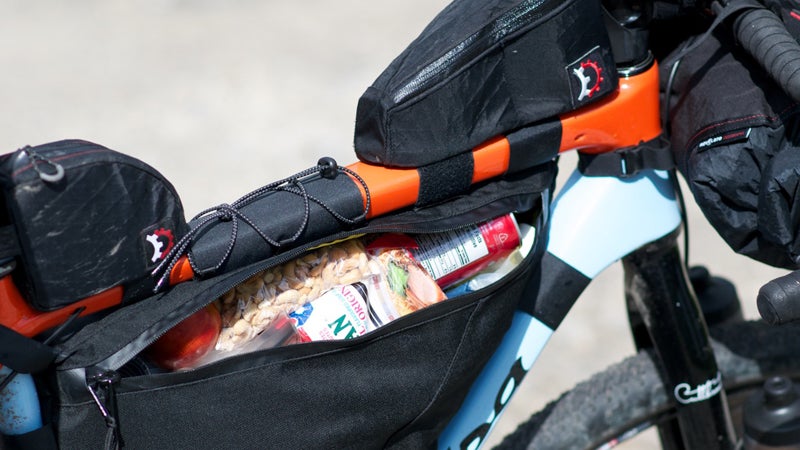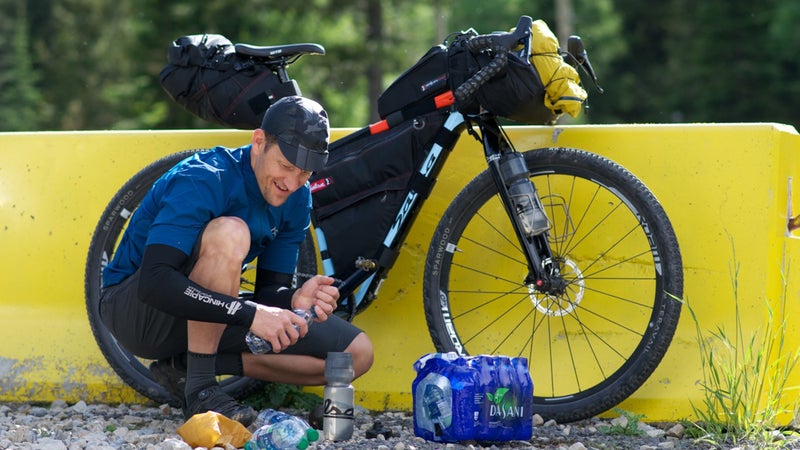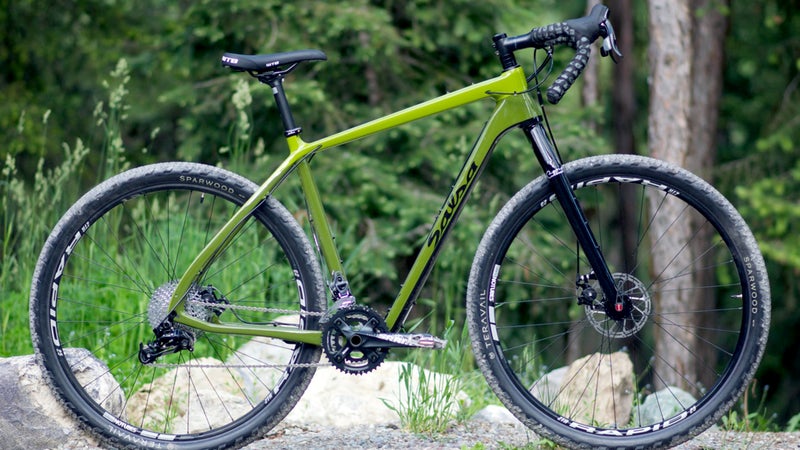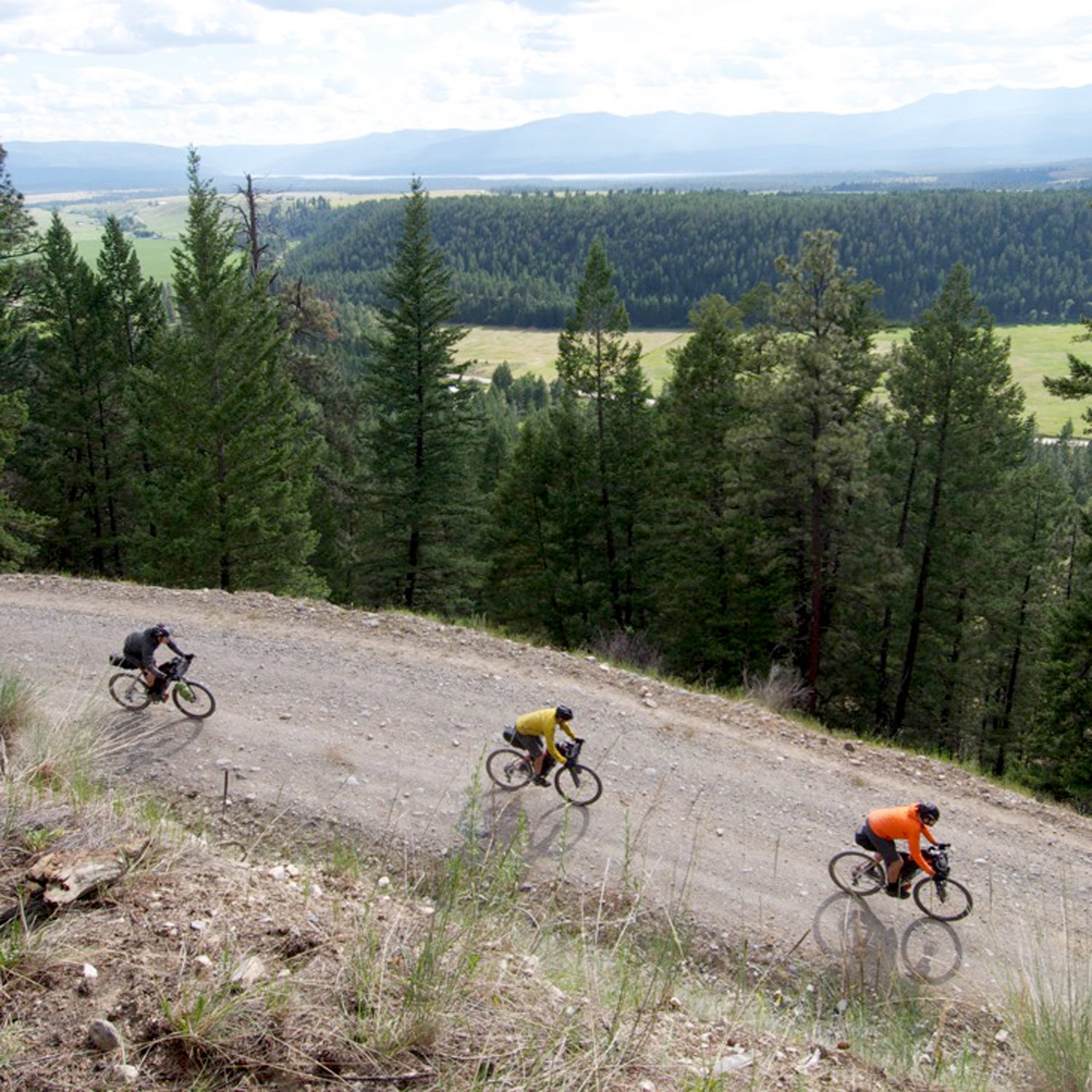A month ago, on the same day that 150-odd riders set out from Banff for the 2,745-mile Tour Divide, I pedaled off on a three-day, 200-mile ride through some of the course’s northernmost miles. The goal was to test the new , the hard tail mountain bike Salsa launched a few days earlier as the ultimate rig for this demanding race. In crafting a fully rigid, drop-bar mountain bike, Salsa re-upped its commitment to the bikepacking segment, still a small part of the market but one that’s gaining steam, as evidenced by the recent attention from the likes of Rocky Mountain, Blackburn, and even Specialized.
The Takeaway
The Good: The full carbon frame is both supple and beautiful, and the spears of contrasting color on the chainstays are especially striking. There’s tons of space in that oversize front triangle for carrying everything you need on long adventures. We love the attention to details, too, including braze-ons for factory bags and even a frame clip for routing a hydration hose out of the frame bag. And all the spec is equally sorted, including a quality saddle and cushy bar tape, so you won’t need to spend a fortune on upgrades.
The Bad: We might be in the minority, but we’d much rather have seen a 2×10 drivetrain on the top spec Cutthroat. Given the bike’s endurance aspirations, a broader range of gears is always welcome.
The Verdict: For an adventure mountain bike that’s primarily aimed at bikepacking, it'll be hard to find a better rig than the Cutthroat. (The ?) This bike is fast and snappy like you’d expect from a race bike, but still plenty comfortable and stable for long-distance cruising. And it rides as smooth as a Cadillac when loaded up with gear. Our only question: Is there a big enough market to support such a beautifully designed, but niche, bicycle?
The Specs
- �±����:��21 lbs
- �ѳ����:��$3,999
- Rear Der: SRAM Rival 1
- ����������:��Rival Hydro
- �³������:��SRAM Roam 40, tubeless
The Test
In Canada, I was riding alongside two other journalists and a couple of guys from Salsa Cycles who conceived and built the Cutthroat. Our plan was to watch the start of the race in Banff, then drive three hours south to the little hamlet of Sparwood, through which the fastest racers would pass later that day. We’d ride the Canadian Flathead section of the course, which traverses some deep, north woods wilderness, before popping out at Roosville for the border crossing into the U.S. Then, after resupplying in Eureka, we’d weave back into the American Flathead and power down to Whitefish. The stretch is said to be some of the most remote and pristine terrain on the entire Tour Divide, second perhaps only to the Gila in New Mexico, one of the only other parts of the course I’ve ridden.
Just being at the start of the Tour Divide made the trip up north worth it. It’s easy to think of these riders as superhuman athletes—and it’s true that many of them conjure prodigious performances—but most of the field is just regular folk like you and me who have simply decided to take on a big adventure. It was useful information for me because, with a few years of endurance mountain bike experience under my belt, I planned to use this launch to size up a possible attempt at the full race in coming years.
Our guides for the three days of riding were Joe Meiser, Salsa’s product manager, and Sean Mailen, product design engineer, both of whom have previously ridden the full Tour Divide. Drawing on that experience, as well as input from past winners like Petervary and Kurt Refsnider, Meiser and Mailen were at the heart of the team that made the Cutthroat a reality. Salsa rides by the motto, “adventure by bike,” and the fact that their staff are out putting their bikes through the paces is, I believe, part of what makes their designs so good.
The Frame
Particularities of the Cutthroat include geometry and carbon layup that favors stability and comfort, sharply flattened-out tubes to allow as much cargo space in the main triangle as possible, clearance for up-to 2.4-inch-wide tires, and Salsa’s Woodchipper drop handlebars. The rear triangle has seat stays that flare outward paired to chain stays that bend inward, a configuration that Mailen said acts like a leaf spring to absorb road vibration. And while the carbon fork may seem like an odd choice, most Divide riders will tell you that reliability and weight-savings of a rigid front end is the best choice for this demanding race. (The Cutthroat is, however, suspension-corrected for those who prefer squish.)

Packing the bike for our ride highlighted the smart design. The main triangle is so big that between the frame bag, seat bag, and bar bag—all from Salsa’s partner, Revelate Designs—I was able to carry everything I needed for our tour (including sleep kit, food, and water) without a backpack.

Drop Bars? Really?
The drop bars, which at first seemed like an odd choice on a mountain bike, won me over. Climbing out of the saddle in the hoods felt much more natural than on flat bars, the drops provided exceptional stability on long, washboard descents, and as ride times stretched out to six and eight hours I appreciated the variety of hand positions. We even negotiated a few miles of twisty singletrack on the Cutthroat, and the drop bars felt unexpectedly good—though not enough so that I’d trade them out on my trail bike.
The Ride
Day one of our tour took in some of most rugged terrain on the entire Tour Divide, with miles of stream-soaked, rubble-choked roads. The weather was just as inhospitable, as rain and sleet turned the evening hours to a wet, cold, muddy grind. The Cutthroat shined in these harsh conditions, with the handling neutral and stable enough for the tricky surfaces and the carbon frame taking the edge off even the roughest two-track passages. Despite being loaded with close to 15 pounds of gear and provisions, the Cutthroat, which weighs just 21 pounds naked, never felt heavy or sluggish. It’s a testament to carbon fiber’s lightweight compliance—for a long tour like this, no other frame material can compare, except perhaps steel, though of course that comes with a weight penalty.
The Build
I’ve always appreciated Salsa’s smart, high-value spec choices, and the trend continues on the Cutthroat. The SRAM Rival Hydro disc brakes provide excellent modulation and stopping power on the lumpy terrain, the Roam 40 wheels blend high performance and low weight at a reasonable cost, and even the WTB Volt saddle and house-brand gel bar tape felt great for our 200 miles of riding. Our bikes were also spec’d with 2.1-inch Sparwood tires from Teravail, a new brand from Salsa’s parent company QBP. The combination of a fast-rolling center and chunkier side knobs were perfect for the course, and Petervary rode his set the entire 2,745 miles without a flat. Because of production limitations, these tires won’t come stock this year, but they’ll be worth searching out as soon as they’re available.
My only major objection with the Cutthroat was 1×11 drivetrain, including a 36-tooth ring up front and a 10-42 cassette. I favor a high-cadence, spinning ride, and on long days over big passes this gearing bogged me down. I’d argue that the 2×10 setup on the second-tier Cutthroat X9 is the better bet for most people, though if I were buying this bike to race the Divide I’d likely go with the frame-only option and consider something like the 48-34 front ratio that Petervary ran. This is, however, a personal preference, and it’s worth noting that women’s winner Lael Wilcox said she had more than enough gears with her 36-ring, 1×11 setup.

A few people also object to Salsa’s decision to use a press-fit bottom bracket (PF41) as opposed to a threaded model. Many people complain about the durability of press-fit designs, and on a bike that’s meant to go into the middle of nowhere, possible failure points raise the specter of getting stranded. Having said that, the truth is that given the simplicity of using them in manufacturing, press-fit BBs are mostly inevitable, and if installed and maintained properly, they are unlikely to fail catastrophically. Sure, you might develop a squeak at some point, but it’s nothing that a $40 replacement won’t fix.
The Cutthroat will be available as both a frameset ($1,999) and in two complete builds. The Cutthroat Carbon Rival 1 ($3,999) gets a 1×11 drivetrain, SRAM hydraulic Rival Hydro brakes, and SRAM Roam 40 wheels. The Cutthroat Carbon X9 ($2,999) uses the same frame and fork as it’s more expensive older brother but gets a 2×10 setup, mechanical disc brakes, and No Tubes Rapid 25 wheels.
The Race
So new was the Cutthroat that the only racer who got one for this year’s Divide was Jay Petervary, who was hoping to use the new bike to improve on his three-year-old course record. In the end, Petervary didn’t quite manage to win, as upstart Josh Kato caught and overhauled him in the last 12 hours. That might seem like a ding against the new bike, especially considering that Kato won aboard a Salsa Fargo, but the gap was a tiny 25 minutes and both men, along with the three riders behind them, rode the course faster than the previous record. That alone should prove the Cutthroat’s chops.
As for me, I rode away from the Tour Divide uncertain of whether I’ll ever toe the line for the full event. On one hand, the wilderness we cruised through was gorgeous and rugged, and I loved the long miles and nights under the stars. But I wonder if I’d appreciate them as much if I were logging 160 or more miles a day, which is what I’d have to do for a fast finish. And that sort of pace would mean you’d miss out on spots like Polebridge Mercantile, a sweet little detour we made on our last day for huckleberry scones, espresso, and a languid afternoon on the deck.
Still, the purity of the idea of riding the crest of the continent remains appealing enough that I’ve yet to write it off. And one thing is for sure: If I ever decide to take on the Divide, the Cutthroat will top my list of bikes to consider for the ride.


